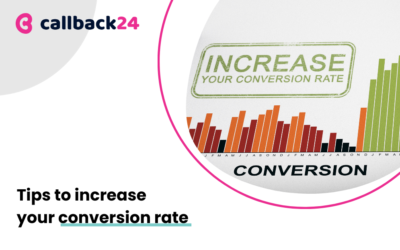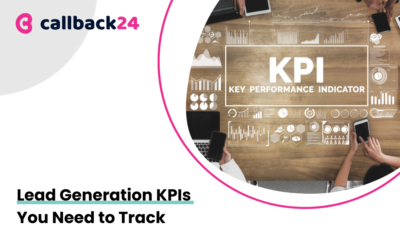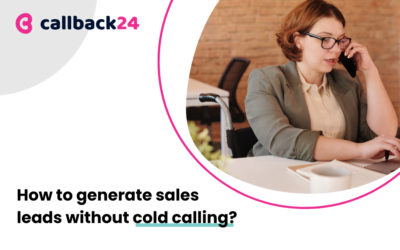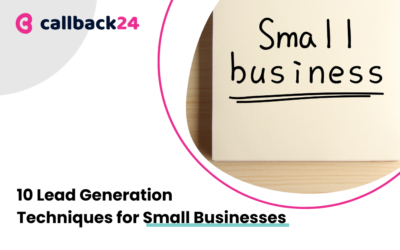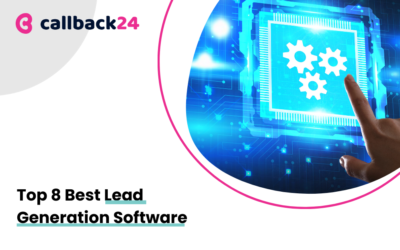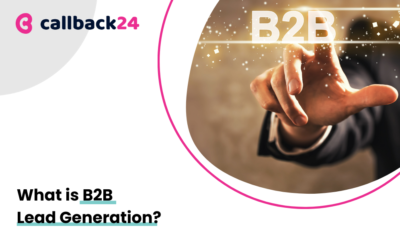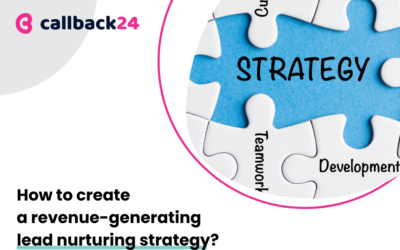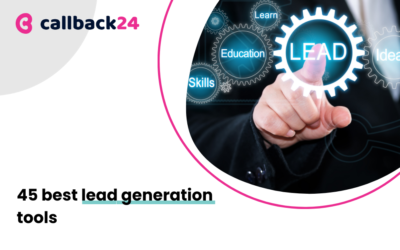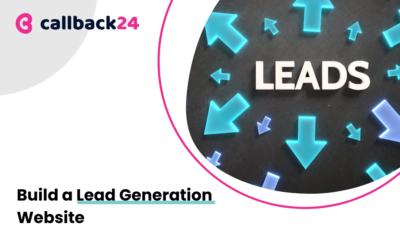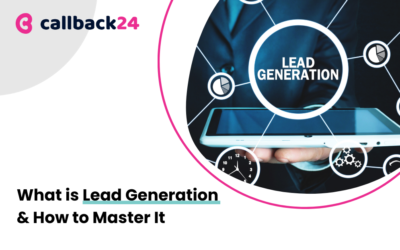TL;DR
- A sales funnel is a process that businesses use to track and measure progress toward achieving their sales goals. The sales funnel typically starts with initial contact with a potential customer, followed by further communication and eventually a sale.
- If you’re looking to improve your sales funnels, there are a few key areas to focus on: existing customers can be a great source of leads for future sales; social media can be used to generate new prospects; keep an eye on all stages of the lead funnel; provide targeted content offers regularly.
- Lead funnel is the process of nurturing leads through the various stages of the sales funnel, from awareness to conversion. There are four main steps to creating an effective lead generation funnel: attracting visitors to your website or landing page, capturing leads with forms or calls-to-action (CTAs), nurturing leads with targeted content, and converting leads into customers.
- A landing page is a key to having a good lead generation funnel and driving traffic to your website. By creating a well-designed landing page, you can three stages: capture the attention of your target audience, persuade them that your product or service is the right solution for them, and motivate them to take action.
- Callback24 is a solution for businesses of all sizes that improve customer experience and increases sales. The tool works 24/7 and saves all call history, including incoming, outgoing, and callback calls. Thanks to the widget you will call the customer back immediately and you won’t lose him.
A conversion funnel reflects a visually recognizable stage in an incoming buyer’s life cycle. What are a sales funnel? What is a lead funnel? How to create an effective lead generation funnel? For this and many other questions, you will find the answer in this article.
Customer journey and its main stages
The customer journey is the process that potential customers go through when they become aware of your product or service and decide whether or not to purchase it.
There are three main stages to the customer journey: awareness, consideration, and decision.
In the awareness stage, customers are just becoming aware of your product or service. They may not even be sure that they need it yet, but they are starting to become aware of its existence. At this stage, your goal is to get your product or service in front of as many people as possible so that they can become aware of it.
There are many different lead generation channels that you can use to reach potential customers in the awareness stage. Some popular ones include content marketing, search engine optimization (SEO), pay-per-click (PPC) advertising, and social media marketing.
In the consideration stage, customers have now become aware of your product or service and are starting to consider whether or not it is right for them. They may be comparing your product or service to similar ones on the market and considering its features, benefits, and price. At this stage, your goal is to provide customers with more information about your product or service so that they can make an informed decision.
What is a sales funnel?
A sales funnel is a process that businesses use to track and measure progress toward achieving their sales goals. The sales funnel typically starts with initial contact with a potential customer, followed by further communication and eventually a sale.
The sales funnel is important because it helps businesses to focus their efforts on the most promising leads, and track their progress toward their sales goals. By understanding where customers are in the sales funnel, businesses can make sure they are providing the right level of support and communication at each stage.
How to improve sales funnels?
If you’re looking to improve your sales funnels, there are a few key areas to focus on. First, existing customers can be a great source of leads for future sales. Make sure you’re staying in touch with them and keeping them updated on your latest products and offerings.
Secondly, social media can be a great way to generate leads and move them through the sales funnel stages. Create compelling content and post it regularly to attract potential customers.
Finally, keep an eye on your lead funnel stages and make sure you’re nurturing leads throughout the entire process. By following these tips, you can improve your sales funnels and boost your overall sales.
What is a lead funnel?
The lead funnel is a process businesses use to generate and qualify leads. Lead funneling begins with marketing activities that attract interest and create demand for a product or service.
Once potential customers are aware of the offering, they enter the second stage of the lead funnel where they are engaged with targeted content that further educates them about the offering. In the final stage, leads are converted into customers through a sales process.
The typical lead funnel has four stages:
Stage 1: Awareness
At this stage, potential customers are made aware of your product or service through marketing efforts such as advertising, public relations, or content marketing.
Stage 2: Interest
Once customers are aware of your product or service, they begin to show interest in what you have to offer. They may visit your website, request more information, or sign up for a free trial.
Stage 3: Consideration
At this stage, potential customers are evaluating your product or service to see if it meets their needs. They may compare you to your competitors, read online reviews, or request a demo or price quote.
Stage 4: Conversion
Finally, customers are ready to purchase your product or service. They may fill out a form, make a phone call, or complete an online purchase.
What is a lead generation funnel?
A lead generation funnel is a marketing strategy used to generate leads and move them through different stages of the sales process.
The lead generation funnel typically consists of four different stages:
- Attracting attention
In this stage, you need to grab the attention of your target audience and make them aware of your product or service. This can be done through various marketing channels such as content marketing, social media marketing, and paid advertising.
- Engaging and interest
Once you have their attention, you need to engage with your audience and get them interested in what you have to offer. This can be done by providing more information about your product or service, offering free trials or demos, and creating interesting content.
- Converting to a lead
In this stage, you need to convert your interested prospects into leads. This can be done by asking for their contact information in exchange for something valuable such as an eBook or white paper.
- Nurturing the lead
Once you have converted a prospect into a lead, you need to nurture them until they are ready to buy your product or service. This can be done by providing more information, staying in touch, and following up.
How to create an effective lead generation funnel?
There are four main steps to creating an effective lead generation funnel:
- Attracting visitors to your website or landing page
The first step in creating lead generation funnel is attracting visitors to your website or landing page. There are a number of ways to do this, but some of the most effective include search engine optimization (SEO), pay-per-click (PPC) advertising, and content marketing.
- Capturing leads with forms or calls-to-action (CTAs)
Once you have visitors on your website or landing page, the next step is to capture their contact information with forms or calls-to-action (CTAs). Forms are typically used to capture leads’ contact information, while CTAs can be used to encourage visitors to take a specific action, such as downloading a white paper or e-book.
- Nurturing leads with targeted content
Once you have captured a lead’s contact information, the next step to making a lead generation funnel is to nurture them with targeted content. This can be done through email marketing, lead nurturing programs, and targeted content offers.
- Converting leads into customers
The final step in the funnel is converting leads into customers. This can be done through a variety of methods, such as sales calls, webinars, and free trials.
Lead generation is important
One of the most important aspects of any business is generating leads. Without leads, there would be no customers or clients and, consequently, no revenue. Therefore, it’s essential to have a lead generation strategy in place in order to ensure that your business is constantly bringing in new prospects.
There are many different lead generation channels that you can use, but not all of them will be equally effective for every business. It’s important to choose the right mix of channels that will work best for your particular products or services.
What is a sales pipeline?
A sales pipeline is the process that companies use to move to pay customers through the conversion funnel. The sales pipeline begins with leads, which are potential customers that have shown interest in a company’s products or services.
These leads are then converted into opportunities, which are customers that are actively interested in doing business with the company. From there, the opportunities are converted into paying customers.
How can this help companies?
The sales pipeline is an important tool for companies because it helps them track their progress in converting leads into paying customers. It also allows them to measure their conversion rate, which is the number of leads that become paying customers divided by the total number of leads. By tracking their sales pipeline, companies can improve their conversion rate and increase their revenue.
Not all leads are created equal, and not all conversions happen at the same rate. Some leads are more qualified than others, and some conversion rates are higher than others.
That’s why companies need to track their sales pipeline so they can see where their leads are coming from and how quickly they’re being converted into paying customers.
How the final stage of the sales process should look like?
The final stage of the sales process is to attract traffic to your online business. This can be done through various marketing channels, such as search engine optimization (SEO), social media marketing, and pay-per-click (PPC) advertising.
Once you have attracted visitors to your website, it is important to convert them into leads and then customers. This can be done by providing valuable content that helps them solve a problem or by offering a product or service that they need.
It is also important to follow up with your leads and customers after the sale. This can be done through email marketing, phone calls, or even personal visits. By keeping in touch with your customers, you will build relationships and foster loyalty.
What is a good conversion rate?
The conversion rate is the percentage of people who take the desired action (in this case, buying your product) out of the total number of people who see your offer.
There’s no magic number for what constitutes a “good” conversion rate, as it will vary depending on your particular products or services, your target market, and a number of other factors. However, if you’re not seeing the results you want, it may be time to revisit your lead generation funnel and make some tweaks.
Here are a few things you can do to improve your funnel conversion rate:
- Make your offer irresistible:
If you’re not sure what would make your offer more appealing to your target market, try surveying them or conducting customer research.
- Create a sense of urgency
Nobody wants to miss out on a good deal, so create a sense of urgency by offering time-sensitive discounts or bonuses.
- Make it easy to take action
The easier it is for people to take the desired action (in this case, buying your product), the more likely they are to do it. Make sure your buy button is prominently displayed and that the checkout process is simple and straightforward.
- Follow up with leads
If someone doesn’t buy your product right away, that doesn’t mean they’re never going to. Stay in touch with your leads through email marketing or retargeting ads, and you may eventually be able to close the sale.
The lead magnet will improve your business
If you’re not using lead magnets to attract new leads, you’re missing out on a key marketing strategy. Lead magnets are a great way to get more people interested in your business, and they can be used to generate social media posts that drive even more traffic to your website.
What is a lead magnet?
A lead magnet is an irresistible offer that gives people something of value in exchange for their contact information. It’s a great way to grow your email list or social media following while providing value to your target audience.
Lead magnets come in all shapes and sizes, but they all have one thing in common: they offer something that people want or need in exchange for their contact information. It is important to create content that your potential customer wants to get.
Types of lead magnets
There are many different types of lead magnets you can use to grow your social media following. Some popular options include:
- PDF guides or eBooks
- Checklists or cheat sheets
- Templates or worksheets
- Toolkits or resource lists
- Video training or webinars
- Discounts or free trials
How to use lead magnets on social media?
Now that you know what a lead magnet is and some of the different types available, let’s look at how you can use them to grow your social media following.
There are a few different ways you can use lead magnets on social media. The most common is to use them as an incentive to get people to follow you or sign up for your email list.
For example, you could post a link to your lead magnet on social media and say something like, “Follow us for exclusive access to our new eBook!” Or, you could run a social media ad campaign promoting your lead magnet with a call-to-action to sign up for your email list.
You can also use lead magnets to create more engaging social media content. For example, you could create a social media poll or quiz and offer a lead magnet as a prize for those who participate.
What is also important for the business?
A landing page is a key to driving traffic to your website and making initial contact with potential customers. By creating a well-designed landing page, you can do three stages:
- The first stage
Capture the attention of your target audience. This can be done through an eye-catching headline, strong imagery, or an engaging video.
- The second stage
Persuade your target audience that your product or service is the right solution for them. This can be done through testimonials, case studies, or by highlighting the features and benefits of your offering.
- The third stage
Motivate your target audience to take action, such as signing up for a free trial or downloading a white paper. This can be done through a strong call-to-action, or by offering a discount for taking action.
How to make good landing pages?
The landing page it’s a key component of any business website. They’re the first stage in your customer’s journey, and they play a crucial role in driving conversions.
To make sure your landing pages are effective, there are a few things you should keep in mind. Here are a few tips:
- Keep it simple
It should be easy to understand. The last thing you want is for your customers to get confused or lost.
- Make it relevant
Your landing page should be relevant to the products or services you’re selling. If it’s not, you risk losing customers before they even get started.
- Use strong calls to action
Your landing page should have a strong call to action that drives conversions. Without it, your landing page won’t be effective.
- Test landing page regularly
It should be tested regularly to ensure they’re performing optimally. If you don’t, you could be missing out on valuable conversions.
How to get leads from Google Ads?
One of the best ways to get qualified leads is through Google Ads. By targeting your ads specifically to people who are already interested in what you have to offer, you can dramatically increase the chances that they’ll take action and become paying customers. Here’s how you can set up your Google Ads campaign to attract leads:
- Target your keywords carefully
When choosing keywords for your ads, it’s important to select ones that will reach people who are actually interested in what you’re selling. Broad, general keywords may get you more traffic, but they won’t necessarily result in more leads. Instead, focus on specific, targeted keywords that buyers are likely to use when they’re ready to make a purchase.
- Use negative keywords
In addition to targeting specific keywords, you can also exclude certain keywords from your campaigns using negative keywords. This can be helpful in keeping your ads from being shown to people who are not serious about buying what you’re selling. For example, if you’re selling houses, you might want to add “free” as a negative keyword so that your ad doesn’t show up when someone searches for “free houses.”
- Write compelling ad copy
Once you’ve targeted the right keywords, it’s time to write your ad copy. This is where you’ll really need to sell your product or service and convince potential leads that you’re the best choice. Be clear about what you’re offering and why it’s better than the competition.
- Include a call to action
In order for your ads to be effective, you need to include a call to action that encourages leads to take the next step. This could be something like “Sign up now for a free consultation” or “Get more information today.”
- Set up conversion tracking
Conversion tracking is a vital part of any lead generation campaign. Without it, you won’t be able to tell which of your ads are actually resulting in leads. Google Analytics can help you track conversions from your Google Ads campaign so that you can see which ads are performing the best.
Callback24 solution
This is a solution for all types of businesses, also for small businesses. With Callback24 you will improve customer experience and increase your sales thanks to an effective lead generation funnel. Our tool works 24h/7 and saves all call history for you – of incoming, outgoing, and callback calls. You can tag calls (new sale, re-sale, complaint, TV campaign, radio campaign), analyze them and compare the results from each campaign.
What’s more? You can listen to recorded calls. Train your employees and increase the quality of customer service. Reduce CPA (cost per acquisition) by up to 25%! Get to know the buyer’s journey and study phone conversion. Compare data and increase campaign effectiveness. Integrate tool with Google Analytics, Facebook Lead Ads, CRM, and more.
Summary
Making an effective lead generation funnel is important because without it you won’t change a lead into a customer. The lead funnel should be well designed and based on accurate identification and definition of the target audience.
You can make the best lead generation funnel by attracting your customers and encouraging them to stay with you. We highlight the best ways how to do this and it is up to you which of them will be the best for your business. You have to take care of your lead funnel and improve it when it’s needed.



